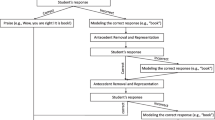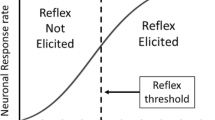Abstract
Stimulus control topography refers to qualitative differences among members of a functional stimulus class. Stimulus control topography coherence refers to the degree of concordance between the stimulus properties specified as relevant by the individual arranging a reinforcement contingency (behavior analyst, experimenter, teacher, etc.) and the stimulus properties that come to control the behavior of the organism (experimental subject, student, etc.) that experiences those contingencies. This paper summarizes the rationale for analyses of discrimination learning outcomes in terms of stimulus control topography coherence and briefly reviews some of the foundational studies that led to this perspective. We also suggest directions for future research, including pursuit of conceptual and methodological challenges to a complete stimulus control topography coherence analysis of processes involved in discriminated and generalized operants.
Similar content being viewed by others
References
Baum, W. M. (2002). From molecular to molar: A paradigm shift in behavior analysis. Journal of the Experimental Analysis of Behavior, 78, 95–116.
Bickel, W. K., & Etzel, B. C. (1985). The quantal nature of controlling stimulus-response relations as measured in tests of stimulus generalization. Journal of the Experimental Analysis of Behavior, 44, 245–270.
Bray, N. W., Fletcher, K. L., & Turner, L. A. (1997). Cognitive competencies and strategy use in individuals with mental retardation. In W. E. MacLean, Jr. (Ed.), Ellis’ handbook of mental deficiency, psychological theory and research (3rd ed., pp. 197–217). Hillsdale, NJ: Erlbaum.
Carter, D. E., & Werner, T. J. (1978). Complex learning and information processing by pigeons: A critical analysis. Journal of the Experimental Analysis of Behavior, 29, 565–601.
Cohen, L. R., Brady, J., & Lowry, M. (1981). The role of differential responding in matching-to-sample and delayed matching performance. In M. L. Commons & J. A. Nevin (Eds.), Quantitative analysis of behavior: Vol. 1. Discriminative properties of reinforcement schedules (pp. 345–364). Cambridge, MA: Ballinger.
Commons, M. L., Nevin, J. A., & Davison, M. C. (1991). Signal detection: Mechanisms, models, and applications. Hillsdale, NJ: Erlbaum.
Cumming, W. W., & Berryman, R. (1965). The complex discriminated operant: Studies of matching-to-sample and related problems. In D. I. Mostofsky (Ed.), Stimulus generalization (pp. 284–330). Stanford, CA: Stanford University Press.
Davison, M., & McCarthy, D. (1988). The matching law: A research review. Hillsdale, NJ: Erlbaum.
Davison, M., & Nevin, J. A. (1999). Stimuli, reinforcers, and behavior: An integration. Journal of the Experimental Analysis of Behavior, 71, 439–482.
Deutsch, C. K., Oross, S., DiFiore, A., & Mc-Ilvane, W. J. (2000). Measuring brain activity correlates of behavior: A methodological overview. Experimental Analysis of Human Behavior Bulletin, 18, 36–42.
Dube, W. V., Lombard, K. M., Farren, K. M., Flusser, D. S., Balsamo, L. M., Fowler, T. R., et al. (2003). Stimulus overselectivity and observing behavior in individuals with mental retardation. In S. Soraci & K. Murata-Soraci (Eds.), Visual information processing (pp. 109–123). Westport, CT: Praeger.
Dube, W. V., & McIlvane, W. J. (1996). Some implications of a stimulus control topography analysis for emergent stimulus classes. In T. R. Zentall & P. M. Smeets (Eds.), Stimulus class formation in humans and animals (pp. 197–218). Amsterdam: Elsevier.
Dube, W. V., & McIlvane, W. J. (2002). Quantitative assessments of sensitivity to reinforcement contingencies in mental retardation. American Journal on Mental Retardation, 107, 136–145.
Dube, W. V., & McIlvane, W. J. (in press). Consequence-sensitivity analysis of motivational processes in mental retardation. In H. Switzky, R. Schalock, L. Hickson, & B. Benson (Eds.), Current perspectives on individual differences in personality and motivation in persons with mental retardation and other developmental disabilities. Academic Press.
Dube, W. V., McIlvane, W. J., & Green, G. (1992). An analysis of generalized identity matching-to-sample test procedures. The Psychological Record, 42, 17–28.
Dube, W. V., McIlvane, W. J., Mackay, H. A., & Stoddard, L. T. (1987). Stimulus class membership established via stimulus-reinforcer relations. Journal of the Experimental Analysis of Behavior, 47, 159–175.
Dube, W. V., McIlvane, W. J., Maguire, R., Mackay, H. A., & Stoddard, L. T. (1989). Stimulus class formation and stimulus-reinorcer relations. Journal of the Experimental Analysis of Behavior, 51, 65–76.
Estávez, A. F., Fuentes, L. J., Overmier, J. B., & Gonzalez, C. (2003). Differential outcomes effect in children and adults with Down syndrome. American Journal on Mental Retardation, 108, 108–116.
Estes, W. K. (1959). The statistical approach to learning theory. In S. Koch (Ed.), Psychology: A study of a science (Vol. 2, pp. 380–491). New York: McGraw-Hill.
Goeters, S., Blakely, E., & Poling, A. (1992). The differential outcomes effect. The Psychological Record, 42, 389–411.
Harlow, H. F. (1950). Analysis of discrimination learning by monkeys. Journal of Experimental Psychology, 40, 26–39.
Hayes, S. C., Barnes-Holmes, D., & Roche, B. (2001). Relational frame theory: A post-Skinnerian account of human language and cognition. New York: Plenum.
Herrnstein, R. J. (1970). On the law of effect. Journal of the Experimental Analysis of Behavior, 13, 243–266.
Holland, J. G., Solomon, C., Doran, J., & Frezza, D. A. (1976). The analysis of behavior in planning instruction. Reading, MA: Addison-Wesley.
Horne, P. J., & Lowe, C. F. (1996). On the origins of naming and other symbolic behavior. Journal of the Experimental Analysis of Behavior, 65, 185–241.
Horner, R. H., Dunlap, G., & Koegel, R. L. (Eds.). (1988). Generalization and maintenance: Life-style changes in applied settings. Baltimore: Paul H. Brookes.
House, B. J., Hanley, M. J., & Magid, D. F. (1979). A limitation on the law of effect. American Journal of Mental Deficiency, 84, 132–136.
Huguenin, N. H., & Touchette, P. E. (1980). Visual attention in retarded adults: Combining stimuli which control incompatible behavior. Journal of the Experimental Analysis of Behavior, 33, 77–86.
Kirby, K. C., & Bickel, W. K. (1988). Toward an explicit analysis of generalization: A stimulus control interpretation. The Behavior Analyst, 11, 115–129.
Levine, M. (1965). Hypothesis behavior. In A. M. Schrier, H. L. Harlow, & F. Stollnitz (Eds.), Behavior of nonhuman primates (Vol. 1, pp. 97–127). New York: Academic Press.
Mackay, H. A., Stromer, R., & Serna, R. W. (1998). Emergent behavior and intellectual functioning: Stimulus classes, generalization and transfer. In S. A. Soraci & W. J. McIlvane (Eds.), Perspectives on fundamental processes in intellectual functioning: A survey of research approaches (Vol. 1, pp. 287–310). Greenwich, CT: Ablex.
Mackintosh, N. J. (1977). Stimulus control: Attentional factors. In W. K. Honig & J. E. R. Staddon (Eds.), Handbook of operant behavior (pp. 481–513). Englewood Cliffs, NJ: Prentice Hall.
Markham, M. R., & Dougher, M. J. (1993). Compound stimuli in emergent relations: Extending the scope of stimulus equivalence. Journal of the Experimental Analysis of Behavior, 60, 529–542.
Markham, M. R., Dougher, M. J., & Augustson, E. A. (2002). Transfer of operant discrimination and respondent elicitation via emergent relations of compound stimuli. The Psychological Record, 52, 325–350.
McIlvane, W. J. (1992). Stimulus control analysis and nonverbal instructional methods for people with intellectual disabilities. In N. W. Bray (Ed.), International review of research in mental retardation (Vol. 18, pp. 55–109). San Diego, CA: Academic Press.
McIlvane, W. J., & Dube, W. V. (1992). Stimulus control shaping and stimulus control topographies. The Behavior Analyst, 15, 89–94.
McIlvane, W. J., Dube, W. V., Kledaras, J. B., Iennaco, F. M., & Stoddard, L. T. (1990). Teaching relational discrimination to individuals with mental retardation: Some problems and possible solutions. American Journal on Mental Retardation, 95, 283–296.
McIlvane, W. J., Kledaras, J. B., Callahan, T. C., & Dube, W. V. (2002). High probability stimulus control topographies with delayed S + onset in a simultaneous discrimination procedure. Journal of the Experimental Analysis of Behavior, 77, 189–198.
McIlvane, W. J., Kledaras, J. B., Dube, W. V., & Stoddard, L. T. (1989). Automated instruction of severely and profoundly retarded individuals. In J. Mulick & R. Antonak (Eds.), Transitions in mental retardation: Vol. 4. Applications and implications of technology (pp. 15–76). Norwood, NJ: Ablex.
McIlvane, W. J., Kledaras, J. B., Stoddard, L. T., & Dube, W. V. (1990). Delayed sample presentation in MTS: Some possible advantages for teaching individuals with developmental limitations. Experimental Analysis of Human Behavior Bulletin, 8, 31–33.
McIlvane, W. J., Serna, R. W., Dube, W. V., & Stromer, R. L. (2000). Stimulus control topography coherence and stimulus equivalence: Reconciling test outcomes with theory. In J. Leslie & D. E. Blackman (Eds.), Experimental and applied analysis of human behavior (pp. 85–110). Reno NV: Context Press.
Ray, B. A. (1969). Selective attention: The effects of combining stimuli which control incompatible behavior. Journal of the Experimental Analysis of Behavior, 12, 539–550.
Ray, B. A., & Sidman, M. (1970). Reinforcement schedules and stimulus control. In W. N. Schoenfeld (Ed.), The theory of reinforcement schedules (pp. 187–214). New York: Apple-ton-Century-Crofts.
Rilling, M. (1977). Stimulus control and inhibitory processes. In W. K. Honig & J. E. R. Staddon (Eds.), Handbook of operant behavior (pp. 432–480). Englewood Cliffs, NJ: Prentice Hall.
Serna, R. (1991). Interchangeability of stimulus terms in five-term contingencies. Experimental Analysis of Human Behavior Bulletin, 9, 2–3.
Sidman, M. (1969). Generalization gradients and stimulus control in delayed matching-to-sample. Journal of the Experimental Analysis of Behavior, 33, 285–289.
Sidman, M. (1979). Remarks. Behaviorism, 7, 123–126.
Sidman, M. (1980). A note on the measurement of conditional discrimination. Journal of the Experimental Analysis of Behavior, 33, 285–289.
Sidman, M. (1986). Functional analysis of emergent verbal classes. In T. Thompson & M. D. Zeiler (Eds.), Analysis and integration of behavioral units (pp. 213–245). Hillsdale, NJ: Erlbaum.
Sidman, M. (1992). Adventitious control by the location of comparison stimuli in conditional discriminations. Journal of the Experimental Analysis of Behavior, 58, 173–182.
Sidman, M. (1994). Equivalence relations and behavior: A research story. Boston: Authors Cooperative.
Sidman, M. (2000). Equivalence relations and the reinforcement contingency. Journal of the Experimental Analysis of Behavior, 74, 127–146.
Sidman, M., & Stoddard, L. T. (1966). Programming perception and learning for retarded children. In N. R. Ellis (Ed.), International review of research in mental retardation (Vol. 2, pp. 151–208). New York: Academic Press.
Sidman, M., & Stoddard, L. T. (1967). The effectiveness of fading in programming a simultaneous form discrimination for retarded children. Journal of the Experimental Analysis of Behavior, 10, 3–15.
Skinner, B. F. (1935). The generic nature of the concepts of stimulus and response. Journal of General Psychology, 12, 40–65.
Skinner, B. F. (1953). Science and human behavior. New York: Macmillan.
Stikeleather, G., & Sidman, M. (1990). An instance of spurious equivalence relations. The Analysis of Verbal Behavior, 8, 1–11.
Stoddard, L. T., & McIlvane, W. J. (1989). Establishing auditory stimulus control in profoundly retarded individuals. Research in Developmental Disabilities, 10, 141–151.
Stoddard, L. T., & Sidman, M. (1971a). The removal and restoration of stimulus control. Journal of the Experimental Analysis of Behavior, 16, 143–154.
Stoddard, L. T., & Sidman, M. (1971b). Stimulus control after intradimensional discrimination training. Psychological Reports, 28, 147–157.
Stokes, T., & Baer, D. M. (1977). An implicit technology of generalization. Journal of Applied Behavior Analysis, 10, 349–367.
Stromer, R., McIlvane, W. J., & Serna, R. W. (1993). Complex stimulus control and equivalence. The Psychological Record, 43, 585–598.
Touchette, P. E. (1969). Tilted lines as complex stimuli. Journal of the Experimental Analysis of Behavior, 12, 211–214.
Trapold, M. (1970). Are expectancies based upon different positive reinforcing events discriminably different? Learning and Motivation, 1, 129–140.
Zeaman, D., & House, B. J. (1979). A review of attention theory. In N.R. Ellis (Ed.), Handbook of mental deficiency, psychological theory and research (pp. 63–120). Hillsdale, NJ: Erlbaum.
Author information
Authors and Affiliations
Corresponding authors
Additional information
This research was supported by Grants HD 033802 and HD 039816 from the National Institute of Child Health and Human Development. The contents of this paper are solely the responsibility of the authors and do not necessarily represent the official views of NICHD.
We thank Murray Sidman, Michael Davison, and Tony Nevin for stimulating many of our thoughts and apologize for any inadvertent misrepresentations or inaccuracies in our discussion of their work.
Rights and permissions
About this article
Cite this article
McIlvane, W.J., Dube, W.V. Stimulus control topography coherence theory: Foundations and extensions. BEHAV ANALYST 26, 195–213 (2003). https://doi.org/10.1007/BF03392076
Published:
Issue Date:
DOI: https://doi.org/10.1007/BF03392076




